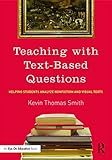Teaching with text-based questions : helping students analyze nonfiction and visual texts / Kevin Thomas Smith.
Series: Eye on education bookPublisher: New York : Routledge, 2014Copyright date: ©2014Description: xvi, 125 pages : illustrations ; 25 cmContent type:- text
- unmediated
- volume
- 9780415744041 (pbk.)
- 0415744040 (pbk.)
- 9780415744034 ()
- 0415744032 ()
- 9781315813219 ()
- 1315813211 ()
- spine title : Teaching with text-based questions
| Item type | Current library | Home library | Collection | Call number | Materials specified | Copy number | Status | Date due | Barcode | |
|---|---|---|---|---|---|---|---|---|---|---|
| AM | PERPUSTAKAAN TUN SERI LANANG | PERPUSTAKAAN TUN SERI LANANG KOLEKSI AM-P. TUN SERI LANANG (ARAS 5) | - | LB1590.3.S635 (Browse shelf(Opens below)) | 1 | Available | 00002142465 |
Includes bibliographical references and index.
Why text-based questions? -- The different types of nonfiction text -- Questions students should be asking about texts -- Working with multiple texts -- Writing good responses to text-based questions -- Evaluating students' responses to text-based questions.
'Help your students navigate complex texts in social studies and across the curriculum! This book shows you how to use a key to text-based question, to build students' literacy and critical thinking skills and meet the common core state standards. You'll learn how to ask text-based questions about different types of nonfiction and visual texts, including primary and secondary sources, maps, charts, and paintings. You'll also get ideas for teaching students to examine point of view, write analytical responses, compare texts, cite textual evidence, and pose their own high-level questions. The book is filled with examples that you can use immediately or modify as needed. Each chapter ends with a reflection section to help you adapt the ideas to your own classroom, helpful information on teaching different types of nonfiction texts, including literary nonfiction, informational texts, primary and secondary sources, and visual texts Ideas for locating primary sources questions students should ask about every text techniques for soliciting higher-order questions from students ways to get students to think critically about the relationships between texts strategies to help students integrate information from different types of sources, tips for teaching students to write good responses to text-based questions, including how to cite sources and incorporate point of view, ideas for using rubrics and peer grading to evaluate students' responses, connections to the informational reading standards of the common core state standards for English language arts for grades 3-12 and of the common core state standards for literacy in history/social studies, science, and technical subjects' -- Provided by publisher.
There are no comments on this title.

